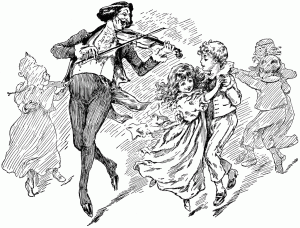Natural Left Hand Technique and Common Misconceptions
Share

When playing becomes second nature
by Rozanna Weinberger
One of the biggest challenges for advancing players is a comfortable left hand technique, including the ability to go from note to note without excessive strain as well as sound finger action & vibrato. There have been many great teachers of string playing, but two come to mind as pioneers shedding light on a more natural use of our bodies, intrinsic to functionality of the skeletal system and muscles. Karen Tuttle and DC Dounis introduced valuable technical understanding utilizing balance, weight and emphasis on minimum effort. In particular the ease or difficulty with which the player went from one note to the next is at the heart of a truly balanced technique.
With respect to left hand technique, DC Dounis stressed developing vertical and horizontal motion. Dounis emphasized an effective finger action could be achieved with fingers nicely curved in relation to finger board whereas the horizontal motion encompasses shifting and even vibrato.
The whole mechanism of shifting consists of knowing how to connect the positions. To master this technicality, the violinist should always remember that each finger must have as a guide another finger, and that the preceding finger is the most natural guide for every finger.
With a systematic set of etudes designed to help the fingers become acquainted with patterns and distances on the fingerboard, the player can cultivates a balanced feeling in the hand by allowing weight to transfer from one note to the next. And yes, while Dounis suggests that effective shifting can be accomplished by going from one finger to the next while keeping the preceding finger down, perhaps the most crucial point is that when the player does finally lift the proceeding note to make the split second leap to the next finger, the hand/fingers must also transfer weight and balance to that next finger. In that split second of transfer of weight the hand/fingers are able to release & rebalance for the next note. Every note of the fingerboard requires a slightly different orientation of the hand so the weight can be transferred into the finger.
Many players make the mistake of thinking that maintaining a shifting finger means the hand should be oriented from the 1st finger. When this happens, players will have a tense squeezing sensation in the thumb and 1st finger, forcing every left hand action to be oriented by the squeezing between the thumb and first finger. Nothing could be further from the truth if play wants to play with efficiency and ease.

While horizontal and vertical motion is absolutely essential to left hand technique, Karen Tuttle seemed to take this principal a step further, emphasizing the ‘release’ or ‘momentum’ needed to go from one note to the next’. Referring to the ‘release’ that happens in the wrist preceding any shift, it might be compared to the bending in the knees before one jumps from one point to the next. Momentum is needed to propel us forward and back. A simple release in the wrist is key to facilitating this momentum just as the knees give a jumper momentum. Imagine for a moment trying to jump from point A to point B without first bending the knees. Playing a musical instrument isn’t so different from this principal.
Thumb placement is a common issue for players. There are as many theories about the placement as there are players. But its important to understand that with a balanced feeling in the left hand, the thumb is counterbalancing the fingers. It is actually a good idea to first discover what the fingers and hand needs to do so the fingers are in a curved shape in relation to the fingerboard. Once this is established THEN the thumb can naturally adjust. to go wherever it feels most natural in relation to the fingers.
‘The object of this work is to indicate a method of solving all of the problems of higher technique in both hands with the least possible expenditure of time and energy.. The whole mechanism in shifting lies in knowing how to connect the positions.’
Many players think that playing well mainly involves training the arms and fingers. But how many think of it as done primarily with the brain and memory?
The true technical training of the violinist is not merely a training of the arm and fingers but, principally, a training of the brain and memory. The fingers and the arm should obey perfectly the intention of the play in order to be able to perform any movement with complete mastery…
The Artists Technique of Violin Playing, DC Dounis
Machine like accuracy can be a virtue! In many ways the body is a machine and the ideal string technique ought to feel like a well running machine. That is the underpinning of any great performance combined with a powerful musical voice. As Dounis points out, there are relationships between fingers. But this is because the brain must assess those ‘measurements’- those distances between notes so it can become automatic or mechanized through repetition. That is the point of etudes dealing with shifting and familiarity with the fingerboard. It is a tactile experience that informs the brain and vice versa.

Batting average is so important to professional baseball players!
Batting Average & Machine Like Accuracy
The difference between machine like exactness and perfection that a human being can achieve is important to understand. A machine is hard wired to be exact whereas human beings are not. However we can learn, through trial & error to develop consistency, sufficient to have a very reliable technique and overtime, what might appear like machine like accuracy. A great musicians relies on accuracy and consistency much like a great athlete relies on these qualities.

When playing becomes second nature
Most string players believe that practicing a passage over and over again will lead to mastery of a passage. This is partly true… The HOW is important. Yes REPETITION is vital, but AWARENESS is key. Do we JUDGE each repetition as good or bad, right or wrong, or do we allow ourselves to cultivate pure, nonjudgemental awareness so the brain can process each repetition and fine tune our movements kinesthetically, on such a subtle level, it defies our willful efforts to control the outcome of a technical passage.
Put a different way, consider how an infant eventually learns to walk. Through trial & error, a silent learning process is going on with each fall and every wobble as the young child learns to navigate their ability to walk. But imagine if learning how to walk the same way we teach students to play the violin! First move the foot, then the knee, the the hip, or is it the hip that initiates the walking movement? Such analysis is not uncommon in acquiring violin technique but it becomes clear why such an approach can be less than optimal if one were learning to walk. Letting it happen and letting go are often thrown out as goals when trying not to get in the way of oneself by overthinking a technical passage. But when you consider the many movements we do on a daily basis with machine like exactness, such as walking, running and numerous other functionalities we take for granted, it is evident that humans can move with machine like accuracy as well if we can trust the brain to do its job.
